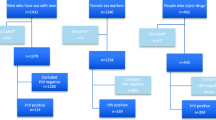Abstract
Ongoing HIV transmission is related to prevalence, risk behavior and viral load among persons with HIV. We assessed the contribution of these factors to HIV transmission with transmission rate models and data reported to National HIV Surveillance and published rates of risk behavior. We also estimated numbers of persons with risk behaviors and unsuppressed viral load among sexual risk groups. The transmission rate is higher considering risk behavior (18.5 infections per 100 people with HIV) than that attributed to unsuppressed viral load (4.6). Since persons without risk behavior or suppressed viral load presumably transmit HIV at very low rates, transmission can be attributed to a combination of these factors (28.9). Service needs are greatest for MSM; their number with unsuppressed viral load engaging in unprotected discordant sex was 8 times the number of male heterosexuals and more than twice the number of female heterosexuals with high-risk transmission potential. While all persons with HIV need optimal care, treatment as prevention is most relevant when risk behavior is present among persons with unsuppressed HIV viral load.
Similar content being viewed by others
References
Last JM. A dictionary of epidemiology. New York: Oxford University Press; 1995.
Hall HI, Song R, Rhodes P, Prejean J, An Q, Lee LM, et al. Estimation of HIV incidence in the United States. JAMA. 2008;300:520–9.
Prejean J, Song R, Hernandez A, Ziebell R, Green T, Walker F, et al. Estimated HIV incidence in the United States, 2006–2008. PLoS One. 2011;6:e17502. doi:10.1371/journal.pone.0017502.
Centers for Disease Control and Prevention. HIV Surveillance Report, 2010. http://www.cdc.gov/hiv/topics/surveillance/resources/reports/ (2012). Accessed 14 Oct 2012.
Holtgrave DR, Hall HI, Rhodes PH, Wolitski RJ. Updated annual HIV transmission rates in the United States, 1978–2006. J Acquir Immune Defic Syndr. 2009;50:236–8.
Holtgrave DR, Hall HI, Prejean J. HIV transmission rates in the United States, 2006–2008. Open AIDS J. 2012;6:20–2.
Hall HI, Holtgrave DR, Maulsby C. HIV transmission rates from persons living with HIV who are aware and unaware of their infection. AIDS. 2012;26:887–96.
Centers for Disease Control and Prevention. Revised recommendations for HIV testing of adults, adolescents, and pregnant women in health-care settings. MMWR. 2006;55:1–17.
Marks G, Crepaz N, Janssen RS. Estimating sexual transmission of HIV from persons aware and unaware that they are infected with the virus in the USA. AIDS. 2006;20:1447–50.
Cohen MS, Muessig KE, Smith MK, Powers K, Kashuba ADM. Antiviral agents and HIV prevention: controversies, conflicts and consensus. AIDS. 2012;26:1585–98.
Pinkerton SD. HIV transmission rate modeling: a primer, review, and extension. AIDS Behav. 2011;16:791–6.
Freedman M, Mattson C, Johnson C, et al. Medical Monitoring Project, 2009 to 2010. National representative estimates of sexual risk behaviors among HIV + adults receiving medical care: U.S. 19th Conference on retroviruses and opportunistic infections. Seattle, Washington, 2012.
Millett GA, Flores SA, Peterson JL, Bakeman R. Explaining disparities in HIV infection among black and white men who have sex with men: a meta-analysis of HIV risk behaviors. AIDS. 2007;21:2083–91.
Panel on Antiretroviral Guidelines for Adults and Adolescents. Guidelines for the use of antiretroviral agents in HIV-1-infected adults and adolescents. Department of Health and Human Services, 1–239. 2012. http://www.aidsinfo.nih.gov/ContentFiles/AdultandAdolescentGL.pdf. Accessed 20 April 2012.
The White House Office of National AIDS Policy. National HIV/AIDS strategy for the United States. 2010. http://www.whitehouse.gov/administration/eop/onap/nhas/. Accessed 20 April 2012.
Marks G, Gardner LI, Craw J, Giordano TP, Mugavero MJ, Keruly JC, et al. The spectrum of engagement in HIV care: do more than 19 % of HIV-infected persons in the US have undetectable viral load? Clin Infect Dis. 2012;53(11):1168–9. doi:10.1093/cid/cir678.
Hasse B, Ledergerber B, Hirschel B, Vernazza P, Glass TR, Jeannin A, et al. Frequency and determinants of unprotected sex among HIV-infected persons: the Swiss HIV Cohort Study. Clin Infect Dis. 2010;51:1314–22.
Heijman T, Geskus RB, Davidovich U, Coutinho RA, Prins M, Stolte IG. Less decrease in risk behaviour from pre-HIV to post-HIV seroconversion among MSM in the combination antiretroviral therapy era compared with the pre-combination antiretroviral therapy era. AIDS. 2012;26:489–95.
Centers for Disease Control and Prevention. Monitoring selected national HIV prevention and care objectives by using HIV surveillance data—United States and 6 U.S. dependent areas—2010. HIV Surveillance Supplemental Report 17(No. 3, part A). 2012. http://www.cdc.gov/hiv/topics/surveillance/resources/reports/. Accessed 28 June 2012.
Holtgrave DR, Maulsby C, Wehrmeyer L, Hall HI. Behavioral factors in assessing impact of HIV treatment as prevention. AIDS Behav. 2012;16:1085–91.
Centers for Disease Control and Prevention. High-impact HIV prevention. 2012. http://www.cdc.gov/hiv/strategy/dhap/pdf/nhas_booklet.pdf. Accessed 20 April 2012.
National Alliance of State & Territorial AIDS Directors (NASTAD). ADAP Watch. 2012. http://www.nastad.org/Docs/012236_ADAP%20Watch%20update%20-%202.24.12.pdf. Accessed 20 April 2012.
Centers for Disease Control and Prevention. Vital signs: HIV prevention through care and treatment–United States. MMWR. 2011;60:1618–23.
Hall HI, Gray KM, Tang T, Li J, Shouse L, Mermin J. Retention in care of adults and adolescents living with HIV in 13 U.S. areas. J Acquir Immune Defic Syndr. 2012;60:77–82.
Centers for Disease Control and Prevention. Compendium of evidence-based HIV behavioral interventions: risk reduction chapter. 2012. http://www.cdc.gov/hiv/topics/research/prs/compendium-evidence-based-interventions.htm. Accessed 31 Dec 2012.
Disclaimer
The findings and conclusions in this study are those of the authors and do not necessarily represent the views of the Centers for Disease Control and Prevention.
Author information
Authors and Affiliations
Corresponding author
Rights and permissions
About this article
Cite this article
Hall, H.I., Holtgrave, D.R., Tang, T. et al. HIV Transmission in the United States: Considerations of Viral Load, Risk Behavior, and Health Disparities. AIDS Behav 17, 1632–1636 (2013). https://doi.org/10.1007/s10461-013-0426-z
Published:
Issue Date:
DOI: https://doi.org/10.1007/s10461-013-0426-z




